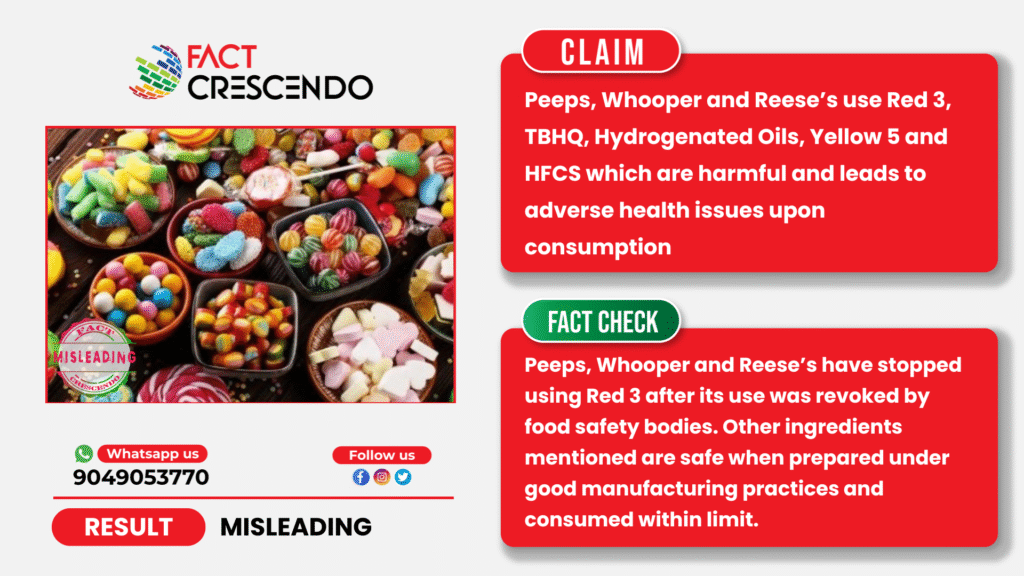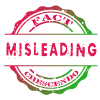
Various chemical dyes and additives have been widely used in food products to enhance visual appeal and lengthen the shelf life of the products. While many of these dyes and additives are considered safe, some have raised health concerns and are under scrutiny. Consumers are raising their voices to ban the products using artificial additives and switch to natural substances citing various adverse health issues that may rise upon consumption of these artificial ingredients.
Against this backdrop, social media posts have accused brands like Peeps, Whoppers, and Reese’s of using additives such as TBHQ and high fructose corn syrup, which are linked to serious health concerns. These posts also highlight the use of artificial dyes like Red 3 and Yellow 5, which have been banned in several countries due to potential health risks.
However, Fact Crescendo found the claim to be misleading. None of the mentioned brands uses Red 3 after it has been banned by food regulatory bodies and also all the other ingredients mentioned in the post meets food safety standards.
Fact Check-
Red 3: First, we checked whether brands like Peeps, Whooper and Reese’s use the color dye Red 3, which was recently banned by the FDA. We found that none of the mentioned brands had listed Red 3 as an ingredient in their products. You can see the list of ingredients of these brands here, here and here.
According to a report, there were few products of Peeps which used Red 3 earlier. After California banned Red 3 and other three additives, Peeps manufacturer Just Born announced the removal of Red 3 dye from its products after the 2024 Easter season. This law came into action after Red 3 was found to link with cancer and behavioral issues in children.
In January 2025, the U.S. The Food and Drug Administration (FDA) decided to ban the use of Red Dye No. 3 in food and drugs after it found a risk of cancer in animal studies. FDA also stated that the way Red 3 causes cancer in rats does not apply to humans as human consumption is much lower. However, under Delaney Clause, it banned the dye and instructed manufacturers to stop using the dye by 15 January 2027 and drug companies by 18 January 2028.
Let’s look at the facts of other ingredients mentioned in the post.
Yellow 5: The EFSA reviewed the safety of Yellow 5, also known as Tartrazine is a yellow food dye used in many products. Older studies showed that only a tiny amount of Tartrazine is absorbed by the body, while most of it is broken down by gut bacteria and leaves the body in urine. An acceptable daily intake (ADI) of 7.5 mg per kg of body weight was set many years ago, but the studies used were not detailed enough or focused on mixtures of dyes instead of just Tartrazine. Because of this, EFSA advised for more research to fully understand if Tartrazine is safe and if the ADI needs to be updated.
FDA has also approved the use of Yellow 5 in confections, cereals, snack foods, condiments, baked goods and yogurt.
Hydrogenated Oils: There are two types of hydrogenated oils, partially hydrogenated oil and fully hydrogenated oils.
Partially hydrogenated oils were used in many processed foods like baked goods, margarine, coffee creamer etc. According to a report, these oils contain trans fats, which are harmful to health. In 2015, the FDA declared trans fats as unsafe and revoked its approval to be used in foods.
On the other hand, fully hydrogenated oils undergo different processes and do not create much trans fat. These oils are allowed to be used in foods. Though hydrogenated oils are considered safe, it does not mean they are necessarily good for a person to consume. Products that contain them are often highly processed with added sugar and salt.
TBHQ: The EFSA Panel looked again at the safety of TBHQ (E 319) that is allowed in the EU. It has a safety limit of 0.7 milligrams per kilogram of body weight each day. Earlier reviews showed that adults usually don’t go over this limit. But there were concerns that babies drinking formula with TBHQ might exceed the prescribed limit.
FDA approved TBHQ as a food additive and set specific conditions for its safe use. As per FDA, TBHQ must have a melting point of at least 126.5°C and be at least 99% pure. It should be used as an antioxidant, either alone or with BHA and BHT, to prevent oxidation in foods and the total amount of antioxidants, including TBHQ, in a food must not exceed 0.02% of the fat or oil content in the food.
High Fructose Corn Syrup: A research study on mice showed that high fructose corn syrup (HFCS) may enhance tumor growth by increasing fatty acid production in tumors. Tumors in HFCS-treated mice had higher levels of fatty acids like palmitic acid and stearic acid and showed changes in genes related to fatty acid metabolism. The study also found that HFCS promotes tumor growth by boosting fatty acid synthesis. When the key enzyme for fatty acid production (FASN) was removed in these mice, HFCS could no longer enhance tumor growth, suggesting that fatty acid production plays a key role in the process.
Another study found that too much fructose might lead to obesity and colon cancer in mice. Dr. Goncalves from Weill Cornell Medicine said it’s still unclear whether large amounts of high-fructose corn syrup (HFCS) actually reach the colon in humans. That’s because most of it might be absorbed in the digestive system. In mice, the digestive system is shorter, so it’s easier for HFCS to reach the colon. Dr. Goncalves suggested more research on this is needed.
But, the FDA stated that there is no evidence that HFCS is less safe than other sweeteners like sucrose (table sugar) or honey, which have similar amounts of glucose and fructose. However, the 2010 Dietary Guidelines recommend limiting all added sugars, including HFCS, to maintain a healthy diet, a guideline which the FDA fully supports. HFCS has been listed as generally recognized as safe (GRAS) substance when prepared and used under good manufacturing practice under FDA rules.
Conclusion:
Fact Crescendo found the claim to be misleading. Peeps, Whooper and Reese’s have stopped using Red 3 after its use was revoked by food safety bodies. Other ingredients like hydrogenated oils, high fructose corn syrup, TBHQ and Yellow 5 are permitted to be used in foods when prepared under good manufacturing rules.

Title:All The Ingredients of Peeps, Whoopers and Reese’s Meet Food Safety Standards.
Fact Check By: Siddharth SahuResult: Misleading


